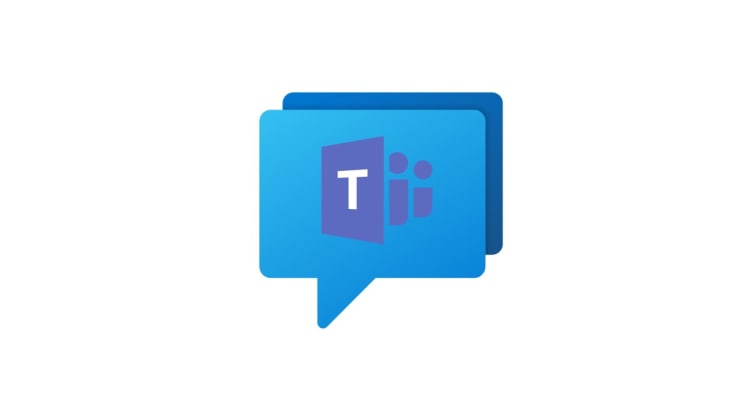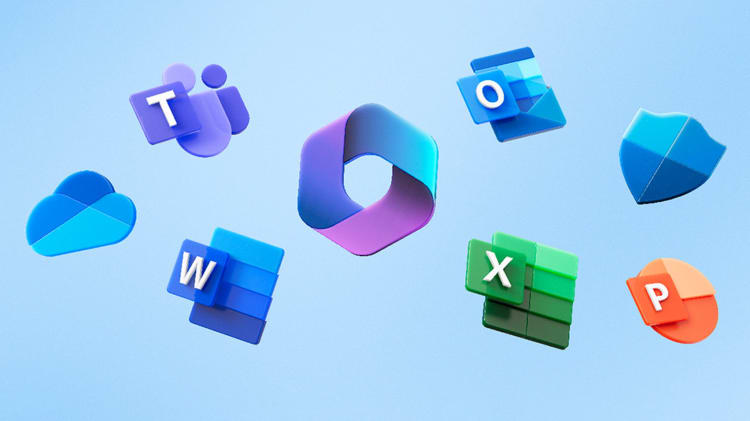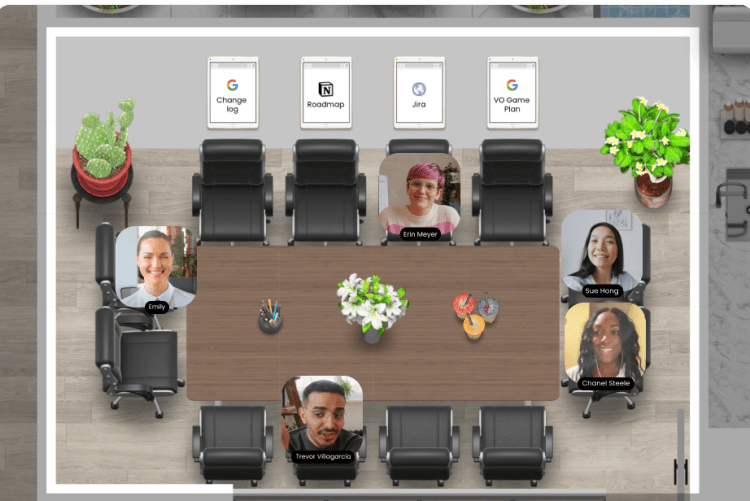Let's be honest, keeping your team connected and productive isn't always easy. With so many collaboration tools out there, finding the right fit can feel overwhelming. That's where Microsoft Teams and Kumospace come in.
Whether you're curious about Microsoft Teams pricing, exploring Microsoft Teams for work, or just trying to figure out which platform makes sense for your team, you're in the right place. Both Microsoft Teams and Kumospace are powerhouse collaboration platforms, but they serve different purposes and excel in different ways.
In this guide, we'll break down everything you need to know about these two tools, from features and pricing to real-world use cases, so you can choose the best solution for your team's unique needs. Let's dive in.
Key takeaways
- Microsoft Teams has evolved significantly since its launch in 2017, with millions of daily active users by 2023.
- Kumospace is a top-ranked collaboration platform that offers an innovative virtual office experience.
- Carefully assess team needs and consider compatibility, customization, cost etc when selecting a collaboration tool to maximize productivity and communication.
Exploring the evolution of Teams Microsoft

Microsoft Teams, launched in 2017, has evolved into a collaboration hub for users, offering an array of tools attempting to achieve effective communication through Teams video calls and other functionalities. Initially competing with platforms like Slack, Teams quickly gained traction and became the most widely used business communication platform, boasting over 100 million users by 2022. This meteoric growth can be attributed to Teams’ focus on user experience, continuous updates, and integration with other Microsoft applications.
The platform has seen numerous updates, improving collaboration and productivity features and integrating with Microsoft applications such as Office 365, SharePoint, and more. This integration allows users to access and collaborate on files, documents, and data within the Teams platform.
The inception and growth
Upon its inception, Microsoft Teams received mixed reviews. While some users appreciated its potential for team collaboration and communication, others expressed concerns and suggestions for improvements. However, user feedback and feature proposals were encouraged, leading to improvements and additions, including custom line-of-business apps and third-party app integration, breakout rooms, and improved calling and meeting features in the web version of Teams.
Much like Kumospace, Microsoft Teams has experienced an increase in its user base over the years.. This remarkable growth can be attributed to its success during the COVID-19 pandemic and its continued momentum.
Microsoft Teams not only offers collaboration tools but also serves as a platform for creating no-code, low-code, and pro-code business apps, further expanding its capabilities.
Major updates and features
Throughout its evolution, Microsoft Teams has undergone multiple updates, each aimed at enhancing user experience and providing more value to its customers. Some of these notable updates include:
- Enhanced notifications
- Team challenges to encourage colleagues
- A personalized dashboard to demonstrate participation
- Spatial audio
- Performance enhancements
These updates ensure a fine collaboration experience.
As it expanded, Microsoft Teams introduced a feature to grant access to non-subscribers, broadening its reach to a larger user base. Updates released in January 2019 catered specifically to retail workers, known as “Firstline Workers,” improving interoperability between different computers. As a result, Microsoft Teams has become a good collaboration tool, providing a range of features to cater to various user needs, though managers should consider factors like cost and interactiveness before making a decision to purchase Teams.
Harnessing the power of Teams meetings

Microsoft Teams Meetings is one of the most powerful features of Microsoft Teams for work, offering everything you need to run productive virtual gatherings, from scheduling and engagement tools to seamless post-meeting collaboration.
Want to keep participants engaged? Microsoft Teams delivers with high-quality video functionality, interactive polls, and collaborative whiteboards perfect for brainstorming sessions. These aren't just fancy add-ons, they're research-backed features designed to make Teams virtual meetings actually work.
And here's the good news: regardless of which Microsoft Teams pricing tier you choose, you'll have access to robust meeting capabilities that help your team collaborate effectively and get real value from every virtual gathering. No more meetings that could've been an email, Microsoft Teams ensures your time together actually counts.
Scheduling and calendar integration
Similar to Kumospace, which integrates with Google Calendar and Outlook, Microsoft Teams simplifies the scheduling process by integrating with calendars, allowing users to:
- Sync their calendar accounts to their Teams accounts
- View and manage their calendar events directly within the Teams app
- Schedule meetings and send meeting invites through the linked Calendar
Engaging participants
Teams Meetings offer various tools like screenshare, whiteboard, and breakout rooms to maintain participant engagement. The whiteboard feature, in particular, can be utilized to promote participant engagement through visual collaboration, interactive discussions, problem-solving, and group activities.
By leveraging these features, Microsoft Teams Meetings creates a reliable video conferencing environment, though users may feel a lack of interactiveness and natural office camaraderie that they’ve come to expect with platforms like Kumospace.
Post-meeting collaboration
After a Teams Meeting, several collaboration tools are at users’ disposal to sustain productivity and communication. These tools include:
- SharePoint Online
- Outlook Groups
- Microsoft Teams
By utilizing these post-meeting collaboration tools, team members can continue to work together seamlessly, maintaining access to shared information and keeping projects on track.
Seamless communication with chat and channels

With less of a focus on organic watercooler conversations, Microsoft Teams provides asynchronous communication through team chats and organized group chat channels. Participants can interact with each other using various options like:
- Text
- Emojis
- Stickers
- GIFs
- Link and file sharing
Persistent group chats
Persistent group chats in Microsoft Teams offer efficient communication, enhance collaboration and coordination, and facilitate easy access and searchability of chat logs. Users can create a persistent group chat by simply inputting the names of the group members they want to include in the chat and beginning the conversation.
These group conversations are preserved and can be accessed at any time, ensuring that important discussions and information are never lost. Remember though, it is crucial for team members to establish connection beyond mere asynchronous communication like text and email. While building camaraderie is no easy feat, business communication platforms like Kumospace have helped thousands of remote teams feel connected and motivated.
Organizing with channels
Channels in Microsoft Teams provide a structured and focused environment for collaboration, enabling team members to concentrate their conversations and files in one place. Channels support threaded conversations, offering a more organized and efficient discussion experience compared to group chats.
By using channels, team members can keep their communications organized so that everyone stays on the same page and works together effectively. Still, it’s best to meet 1 on 1 with team members to achieve the most successful collaboration.
The new Microsoft Teams Essentials for small businesses

Microsoft Teams Essentials, designed for small businesses, is a solution offering features that ease communication with customers and simplify task management. While this option provides the majority of the platform’s communication features at a lower cost, there are many other platforms out there, like Kumospace, which offers Free and Business plans to ensure that all users can benefit from remote team collaboration. Managers ought to consider their use-case and budget to accurately compare platforms and ultimately choose the right platform to enhance their team’s productivity and collaborative efforts.
Connecting with customers
Microsoft Teams Essentials empowers small businesses to establish connections with customers and streamline communications, thereby enhancing productivity and customer service. By integrating Teams Essentials with CRM tools, teams can leverage the collaboration features of Teams and view and collaborate on customer records directly within a Teams chat. Though, itt takes time and resources to be able to truly master this tool.
Enhancing productivity through advanced features

Advanced functionalities in Microsoft Teams, like task management and cloud storage integration, contribute to improved productivity and coordinated collaboration. By utilizing these advanced features, users can ensure that they are making the most of their Teams experience, however there can be a steep learning curve for the less tech-savvy folk.
Task Management
Microsoft Teams provides some task management features, including the Tasks app and integration with Microsoft Planner. This tool enables users to stay focused at both the individual and team level, ensuring that projects stay organized and on track.
With the help of these task management features, teams can stay focused and effectively assign tasks to manage their workload.
Cloud Storage Integration
Cloud storage integration in Microsoft Teams enables users to store and share a variety of data, such as:
- Files
- Documents
- Images
- Videos
Microsoft Teams is integrated with OneDrive and SharePoint as its default cloud storage solutions. Before managers commit to a software, it’s crucial to investigate the software’s security to ensure that data is not being leaked when file sharing.
Integrating with Office 365 and beyond

Teams Microsoft integrates smoothly with Office 365 and third-party apps, thereby broadening its capabilities and offering a more encompassing collaboration experience. By integrating with Office 365 and external apps, Teams allows users to bring together their workplace tools and services. As Kumospace users know, having a lean tech stack is critical for staying organized and streamlining workflows.
Office 365 synergy
The integration of Microsoft Teams with Office 365 offers some advantages, such as productivity and collaboration, enhanced communication and engagement among team members, and streamlined tech stack.
By working in conjunction with Office 365, Microsoft Teams provides a collaboration experience, allowing users to access and collaborate on files, documents, and data within the Teams platform.
Expanding capabilities with third-party apps
Integrating Microsoft Teams with third-party apps provides advantages, such as increased productivity, improved communication and collaboration, expanded functionality, and single sign-on (SSO) mechanisms. Popular examples of integrated third-party apps include Polly, Trello, Salesforce, and GitHub.
It’s advisable to determine which integrations your organization will most benefit from, as different platforms offer different integrations. For example, Kumospace integrates with third party apps like Google Calendar, Outlook, and Slack, to allow users to seamlessly integrate existing workflows and become exponentially more efficient.
Like Teams, by integrating with external apps, Kumospace allows users to access additional features and services that are not natively in Kumospace, ensuring a smooth and comprehensive collaboration experience.
Building community with Teams video calls

Teams Video Calls offer features that foster remote team bonding and facilitate large events, including:
- One-on-one meetings
- Large virtual events
- Conversational chat bubbles
- Interactive virtual games
By leveraging these features, Teams Video Calls can create a dynamic environment, fostering effective communication and collaboration among team members.
Remote team bonding
Teams Video Calls provide features for remote team bonding, including:
- Icebreaker games
- Team building games using video, chat, and whiteboards
- Integration with other Microsoft tools like Word, Excel, PowerPoint, OneNote, SharePoint, and Planner
By utilizing these features, remote teams can foster a sense of camaraderie and engagement, ensuring that they stay connected and collaborate effectively, even when working remotely from different locations.
Hosting large events
Teams Video Calls provide support for large-scale event hosting, with features such as:
- Meetings
- Webinars
- Town halls
- Teams Live Events
These options enable administrators to roll out and configure large-scale meetings, deliver internal events, and broadcast video and meeting content to a large online audience, though it can be resource and time intensive for some teams. .
With Teams Video Calls, hosting and managing large-scale virtual events within the Teams platform can be done, though is not always a breeze to facilitate.
Teams Phone: your modern telephone replacement

Teams Phone acts as a contemporary substitute for traditional telephones, offering calling features and conference call capabilities within the Microsoft Teams platform. By transforming the way users make and receive calls, Teams Phone offers a solution that combines voice and written communication in one platform.
Calling features
Teams Phone offers calling features, including:
- Call answer/initiate
- Call forwarding
- Cloud auto attendants
- Cloud call queues
These features allow users to make and receive calls directly within the Teams app, eliminating the need for separate phone hardware or software.
By incorporating these calling features, Teams Phone provides a modern and efficient solution for voice communication, though it may not be intuitive for all team members.
Conference call capabilities
Teams Phone enables users to host conference calls with multiple participants, with features such as call-in support and the ability to accommodate up to 1000 phone attendees. By providing these conference call capabilities, Teams Phone ensures that users can communicaten, no matter the size of their team (as long as it’s under 1,000 people) or the complexity of their projects.
Exploring Kumospace: a unique collaboration platform

Kumospace, a distinctive business collaboration platform ranked #1 on G2, provides an immersive virtual office environment for remote teams. With features such as customizable virtual spaces, interactive tools for collaboration, and a focus on community-building, Kumospace provides a refreshing alternative to traditional collaboration platforms.
Kumospace features
Kumospace provides a wide range of features to facilitate collaboration and presentations, such as Present, Pop-Out, and Gallery View, Screen share, as well as robust video conferencing with enterprise-grade security like password-protection and guest lists. Visual tools like whiteboarding, annotations, and templates are available, as well as collaboration tools like simultaneous screen sharing and document sharing.
Additionally, Kumospace provides a virtual office space where users can create custom rooms and stay connected to their colleagues even when working remotely from different locations all across the globe.
Why Kumospace?
Kumospace offers a unique and effective option for team collaboration, providing a virtual office atmosphere that bridges the gap between virtual and physical offices. It enables teams to:
- Collaborate and thrive in a virtual office setting
- Facilitate team building
- Encourage bonding between corowkers
With its engaging and dynamic work environment, Kumospace is an excellent choice for remote teams looking to enhance their collaboration experience.
Making the choice: Microsoft Teams, Kumospace, or both?

When choosing between Microsoft Teams, Kumospace, or a combination of both, it’s important to evaluate your collaboration needs and fully utilize your tools. Both platforms offer unique features and benefits. Microsoft Teams provides a collaboration solution that integrates with other Microsoft products, while Kumospace offers a realistic virtual office layout and immersive virtual workspaces that give all the benefits of working in a tradiitional office setting without any of the drawbacks like commuting, office costsm and lack of motivation.
Also, Kumospace, unlike some other dry video chat software, is an immersive and egaging experience that leaves coworkers feeling happy and ready to log on to work.
By carefully evaluating your team’s specific needs and preferences, you can determine the best collaboration tool or combination of tools to optimize productivity and teamwork.
Considerations for your collaboration needs
To choose the right collaboration tool for your business, consider the following factors:
- Compatibility with your business needs
- Customization options
- Software compatibility
- The possibility of trying the tool beforehand
- Availability of support services
- Cost
- Security
- Ease of use
Evaluate your team’s collaboration needs and determine which platform, or combination of platforms, will best serve your team in terms of communication, collaboration, visibility, and team culture. In addition, consider core features like document sharing, task management, and integration with other tools.
Making the most of your collaboration tools
Whether you opt for Teams Microsoft, Kumospace, or both, it’s important to fully utilize the benefits of your chosen collaboration tools. Ensure that your team members are trained in using the platform’s features and encourage open communication and collaboration.
By actively engaging with the tools at your disposal and making the most of their capabilities, you can foster a more productive and connected team.
Summary
Both Microsoft Teams and Kumospace bring something valuable to the table when it comes to team collaboration. The key is figuring out what works best for your specific situation.
If you're weighing Microsoft Teams pricing against your budget, remember that the investment often pays for itself through improved productivity and streamlined communication. Microsoft Teams for work offers enterprise-grade features that scale with your team, while Kumospace provides a more spatial, immersive collaboration experience.
Here's our advice: evaluate your team's actual needs, not just what sounds good on paper. Do you need robust integration with Microsoft 365? Go with Microsoft Teams. Want a more creative, engaging virtual workspace? Kumospace might be your answer. Or better yet, use both where they make sense.
Whichever platform you choose, the real magic happens when your team actually uses it. Encourage open communication, experiment with different features, and create a culture where collaboration isn't just a buzzword, it's how you get things done.
Frequently asked questions
A team meeting is an opportunity to bring your team together, discuss important topics and review goals. A team meeting can be an online meeting or happen face to face. It usually occurs regularly and is led by a meeting leader with a pre-planned agenda.
To join a Teams meeting, select 'Click here to join the meeting' in your meeting invite or use the Teams app on your phone to tap your meeting invitation. If you already have the app, enter the meeting ID and password to join.
You don't need to download Teams in order to join a meeting - you can join it as a guest, or using your browser (Edge or Chrome). All you need is the link from the invite email.
Microsoft Teams is a cloud-based communications platform that enables businesses to collaborate via messaging, video conferencing, calling and file sharing. It is the hub for teamwork within Microsoft 365, but if your looking for a Microsoft alternative, consider engaging and productivty boosting platforms like Kumospace.
Microsoft Teams offers features like audio and video calls and integrates with Microsoft Office, while Kumospace provides a virtual office layout and immersive workspaces for team collaboration and visibility in real time.





